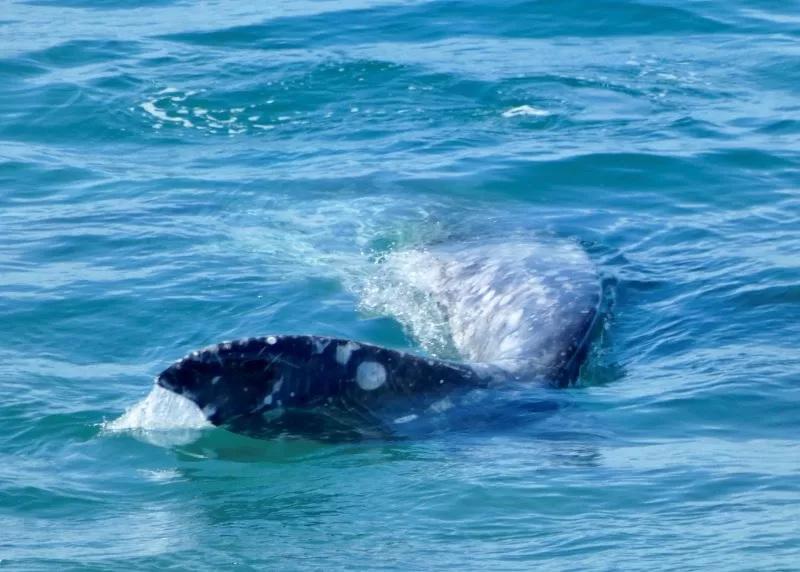
Every spring, California gray whales make a monumental pilgrimage from their winter breeding grounds in the warm lagoons of the Sea of Cortez to their summer feeding grounds in the Arctic. It’s a 12,000-mile round trip, one of the longest migrations of any mammal, and it is getting longer, because melting arctic ice is adding miles to this annual journey.
The southward journey is driven by the urgency of the pregnant females who need to reach the lagoons to safely give birth, but the lagoons are also a gathering place for all Eastern North Pacific gray whales. This is where they mate and rest before heading north once more. On the return journey, mothers with calves stay close to the coast for safety and their progress is slower.
It’s a perilous trip. Gray whales are at risk from ship strikes and can become entangled in nets and other fishing gear. Their ability to communicate with each other is impacted by industrial sound pollution from engines, oil exploration, and underwater explosions. Whale watchers are also a hazard, crowding whales and forcing mothers with calves into deeper water to avoid conflict.
Beginning in 2018, whales faced another major threat: starvation. NOAA Fisheries announced that the species was experiencing a UME—unusual mortality event—that year, a rapid population decline. Sightings of emaciated whales and an unusually high number of fatal strandings continued for several years. Localized ecosystem changes in the arctic and subarctic are thought to have had the major role in the decline that is estimated to have reduced the population by as much as forty percent.
Gray whales build up fat reserves during the summer feeding on bottom-dwelling invertebrates that they dredge up from the mud in their mouths and strain out through two rows of strainer-like baleen. Their preferred food is a shrimp-like amphipod, but this species is adaptable and can eat a wide range of seafloor, or benthic, organisms. This abundant summertime diet enables them to survive without feeding during the entire migration period, although they are sometimes observed foraging for a snack. If something goes wrong with that food chain, the whales face starvation, which is what occurred beginning in 2018.
NOAA Fisheries has just announced that the Unusual Mortality Event involving Eastern North Pacific gray whales is over.
“The increased stranding rate that triggered the Unusual Mortality Event UME declaration is no longer occurring,” a March 14 press release from NOAA states. “While the number of strandings spiked at the start of the UME, they have since declined to annual numbers similar to those recorded before the UME began. The number of calves born to the population also appears to be improving, with other signs that the population may have begun to recover.”
Gray whales are adaptable. A solitary gray whale sighted off Nantucket earlier this month is proof of that. Researchers at the Anderson Cabot Research Center at the New England Aquarium theorize that the whale came through the Northwest Passage through the Arctic that connects the Atlantic and Pacific which has been ice free for several summers.
Research Technician Kate Laemmle, who was part of the team that observed the whale during an aerial survey, wrote: “My brain was trying to process what I was seeing, because this animal was something that should not really exist in these waters. We were laughing because of how wild and exciting this was—to see an animal that disappeared from the Atlantic hundreds of years ago!”
This whale, one of just five sightings of the species outside the Pacific in decades, could be a sign of things to come, a return to the Atlantic, and if nothing else, it has demonstrated the resilience of this species and its ability to find food and survive away from its traditional range.
Climate change and melting ice in the Arctic also mean some gray whales are now being born on the journey south, coming into the world in the open ocean instead of in a protected lagoon.
Volunteers from the California Cetacean Society conduct an annual whale census at Point Fermin, at the tip of the Palos Verdes Peninsula. As of March 11, the census takers have spotted 22 southbound calves—whales that were born on the southbound migration.
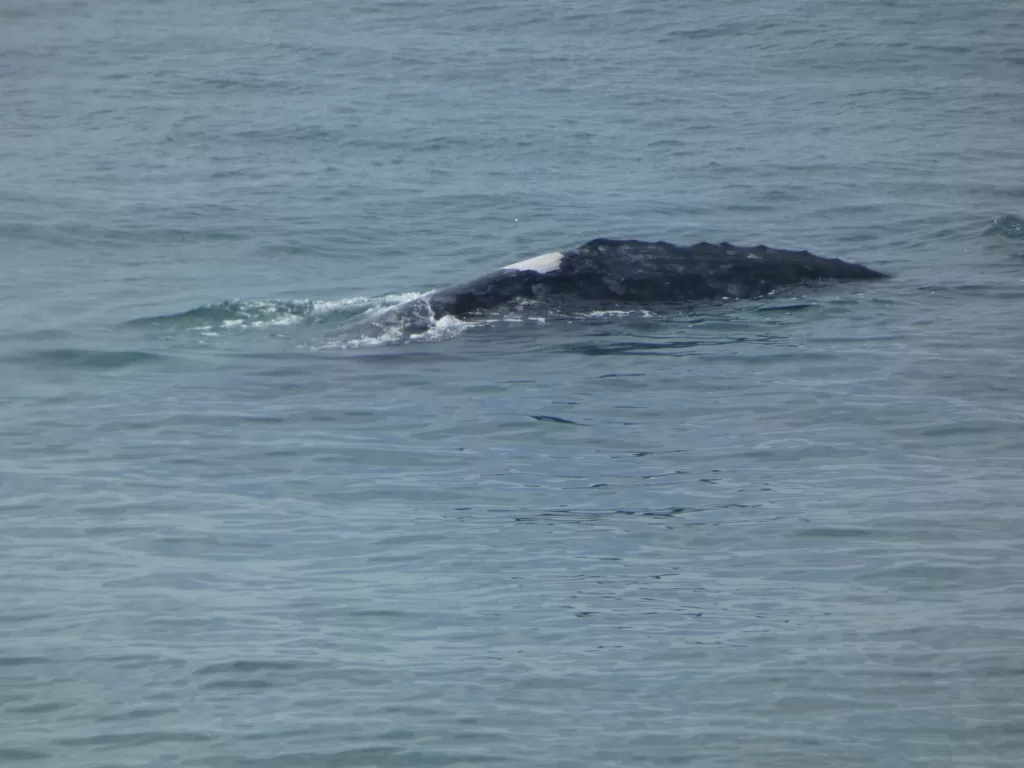
Gray whales have few predators, but calves are preyed on by orca and possibly also by white sharks. Calves are an impressive 14 to 16 feet long at birth and can weigh as much as 2,000 pounds. They quickly grow even larger on a diet of fat-rich milk, but they are still at risk from predators.
The sheltered lagoons of the Sea of Cortez offer protection from predators and rough winter storms. The higher salt content of the water in the Sea of Cortez increases buoyancy, helping newborn whale calves float. The warm water is a protection, too, helping to keep newborns warm until they can develop an insulating layer of blubber. Once in the open ocean they depend on their mothers for protection. Whales that are born in the open ocean face many more challenges, but the presence of 22 of these calves so far this year is a good sign that at least some of these migration babies are surviving.
There is a lot we don’t know about gray whales, their behavior, and their social structure. Unlike the highly organized orca, or “killer whales,” that are this species’ main predator, gray whales do not live in family units and they don’t need to develop cooperative strategies to find food. Gray whales congregate to mate and give birth, and are sometimes observed feeding together, but they tend to travel in small informal groups of two or three during their migration.
During birth, whale “aunties” sometimes attend, helping to lift the newborn to the surface for their first breath, but mothers and calves are usually observed traveling alone together. The calf stays with its mother for around the first nine months of its life, but once it is weaned, it goes its own way.
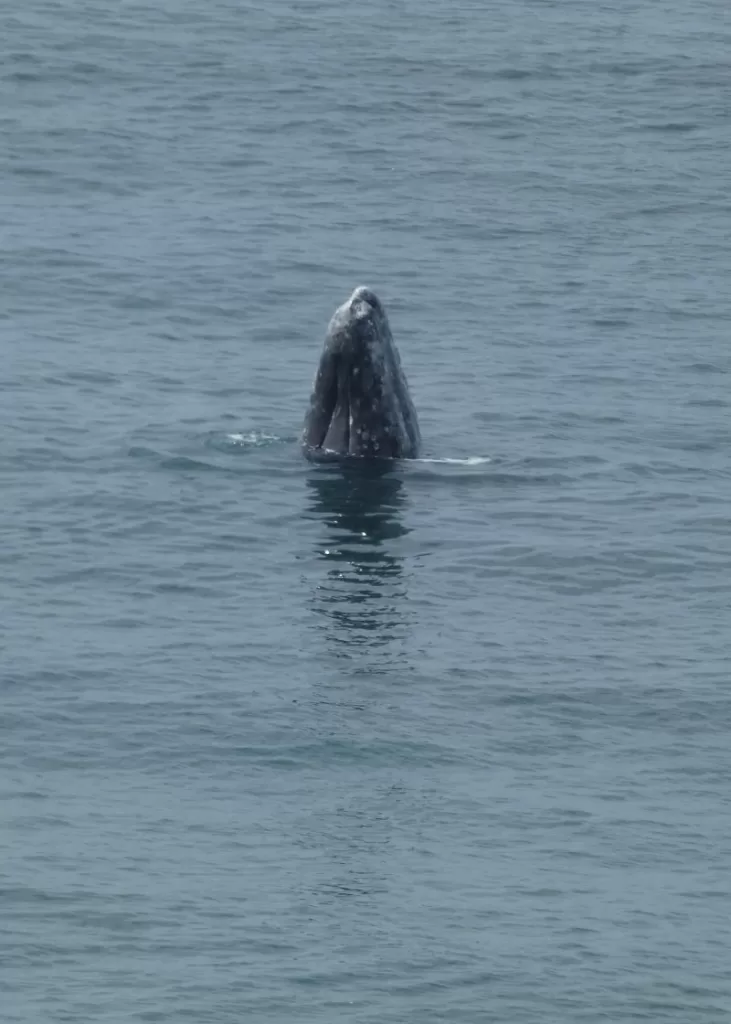
Gray whales can communicate with each other over a long distance underwater, but what they say to each other remains a mystery. Researchers theorize that spy hopping, pectoral flipper slapping and breeching may also be part of gray whale communication, but what the message is remains unknown.
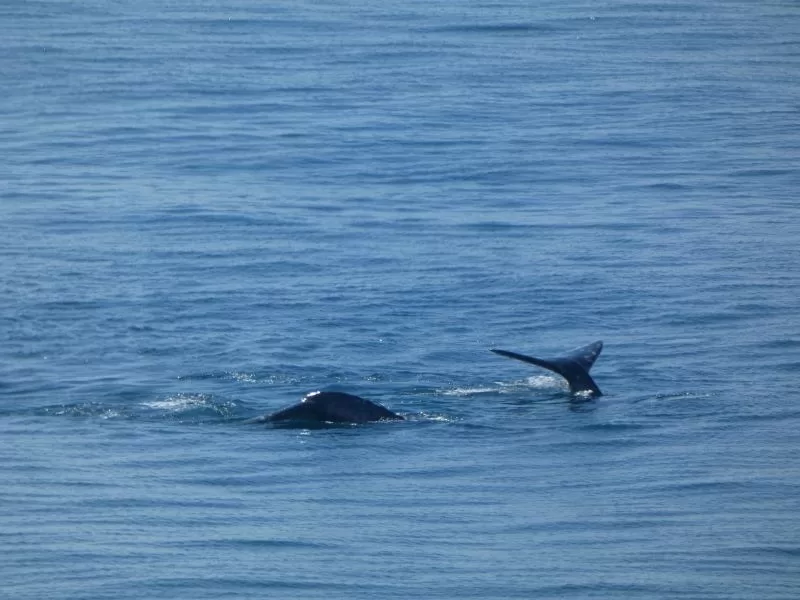
Despite being hunted to the edge of extinction by humans, gray whales appear curious about us, which has earned them the nickname “friendly whales.” They will closely approach whale watching boats and even interact with passengers. One theory is that they simply enjoy the novelty of encountering something new and interesting—which is why humans are out there, too.
As tempting as it may be to get close to a whale, this species is protected by the Marine Mammal Protection Act and all whale watchers, even those in boats or on paddle boards, are required to keep a distance of 100 yards.
March and April are the peak months to look for northbound gray whales off the local coast, but the migration usually runs through May, so there is still time to watch for the passage of these ancient leviathans. Here at the Topanga New Times, your resident naturalist abandons her mountains for the beach, scanning the horizon for the heart-shaped spouts that are the signature sign of this species.
Even though these animals are giants it can still be hard to see them. Adults can grow to be as much as 40-60 feet in length and weigh up to 90,000 pounds, but only a small portion of the whale is visible above the water at any time unless one is fortunate enough to see a whale breach—leaping almost entirely out of the water.
The first thing to look for is any kind of disturbance on the water: a gathering of birds, ripples on the surface of the water, or a line of darker water. All of these can be signs that whales and other marine mammals like dolphins and sea lions are present.
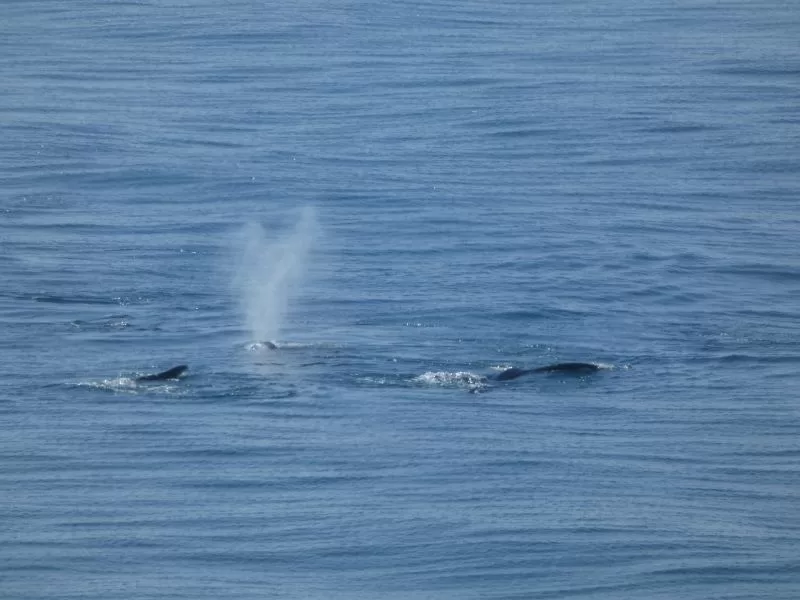
Gray whales can hold their breath for a long time but they must surface eventually to breathe. The spout they produce is the air being exhaled through two air holes before a fresh breath is taken. That breath is a heart-shaped cloud that can be ten feet high. When the whale dives—or sounds—it leaves a “footprint” or more accurately, a “fluke print” produced by the force of its powerful tail propelling the whale deep under the surface. That print is visible on the surface of the water for several seconds after the whale disappears from sight.
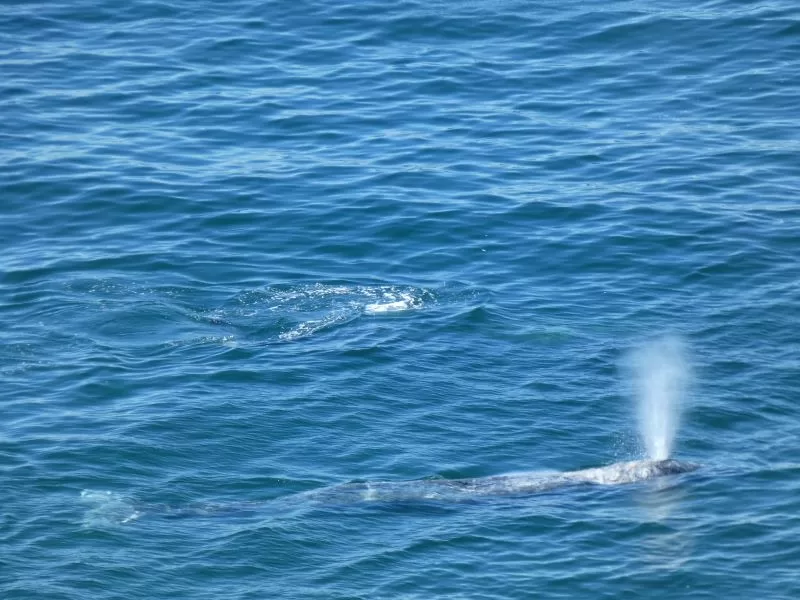
There are plenty of good options for whale watch cruises out of Ventura, Marina Del Rey and San Pedro, but there are also plenty of good vantage points on shore: Corral, Zuma, Leo Carrillo and the small pocket beaches along Pacific Coast Highway between Malibu and Point Mugu beaches are all good spots for whale watching, but the best spot is usually Westward, where the whales often come close to shore.
It’s worth paying to park in the Westward Beach lot at this time of year. Bring a chair and an umbrella and picnic and make a day of it; or walk up to the top of the Point Dume Nature Preserve and watch for whales from one of the viewing platforms.
There are no guarantees in whale watching, whether on a boat or on the beach. One may see a dozen or none at all, but an hour or two spent watching whales is never time wasted.
As of March 14, the Gray Whale Census has counted 219 southbound whales, 332 northbound whales, 22 southbound calves, and 6 northbound. Learn more about the annual Los Angeles Gray Whale Census at https://acs-la.org/gray-whale-census/




